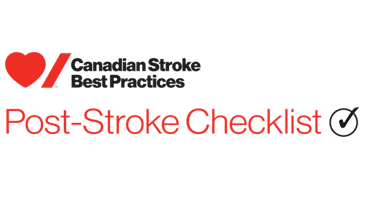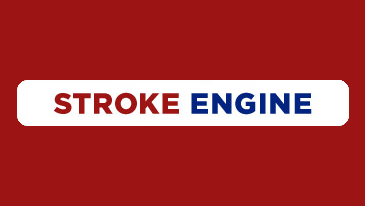- Definition and Considerations
- 1. Supporting People with Stroke, Their Families and Caregivers
- 2. Education for People with Stroke, Their Families and Caregivers
- 3. Interprofessional Care Planning and Communication
- 4. Community Participation Following Stroke
- 5. Transition to Long-Term Care Following a Stroke
- 6. Post Stroke Depression
- 7. Post-Stroke Fatigue
Recommendations
Note: These recommendations apply specifically to persons with stroke living in long-term care or chronic or continuing care settings, including those who were already living in longterm care at the time of their stroke. These recommendations are intended to be implemented in addition to standard care (e.g. physical, functional, emotional, cognitive and social needs) provided in chronic, continuing or long-term care. Recommendations included in other sections of this module, such as Supporting People with Stroke, Their Families and Caregivers (Section 1) and Education for People with Stroke, Their Families and Caregivers (Section 2) also apply to these settings
5.1 Assessment and Care Planning
- All people who transition to a long-term care setting following a stroke should have an initial assessment, conducted by medical, nursing and rehabilitation professionals, as soon as possible after admission [Evidence Level A]. Refer to Rehabilitation module and other sections of this module for information on assessments
- A discharge summary along with the care plan should accompany the individual to long-term care [Evidence Level B]. Refer to Box 3 regarding information to include in the discharge summary.
- Consider aligning the initial assessment of functional, physical, emotional, cognitive, and perceptual status with existing assessment processes (such as the Minimum Data Set-Resident Assessment Inventory (RAI-MDS 2.0); or Multi-clientele Autonomy Assessment in Quebec) where possible [Evidence Level C].
- Assessment results can be used to modify individualized care plans to optimize quality of life and meet functional, physical, emotional, cognitive, and perceptual needs and goals of people who are admitted to long-term care following a stroke [Evidence Level C].
- Individualized care plans may be updated to incorporate changes in care requirements, address issues of safety, and the potential need for referrals to appropriate healthcare professionals for further consultation when declines or improvements are identified during the initial assessment or subsequent reassessments [Evidence Level C].
- Chronic, continuing and long-term care staff members should be knowledgeable in stroke care, maintenance and recovery goals, therapies and stroke best practice recommendations and be provided with updated education in these areas on a regular basis [Evidence Level C]. Refer to HSF’s Taking Action for Optimal Community and Long-Term Stroke Care resource for training content.
5.2 Rehabilitation and Restorative Care
- People who have ongoing rehabilitation goals post-stroke should continue to have access to specialized stroke services (such as physiotherapy, occupational therapy and speech-language therapy) following admission to a community living setting [Evidence Level A], including within a long-term care setting.
- At any point in their recovery, people with stroke living in long-term care who have experienced a change/improvement in functional status and who would benefit from new or additional rehabilitation services should be offered a trial of active inpatient or outpatient rehabilitation [Evidence Level B].
- Residents in long-term care should have access to exercise, leisure opportunities, and support to engage in personally valued activities [Evidence Level B].
5.3 Support and Education for the Person with Stroke and Their Family
- To encourage active participation in care-planning consider providing training, education and support on:
- How to advocate and participate in care planning including access to rehabilitation and restorative care as appropriate and how to be involved in shared decision-making [Evidence Level C].
- Process for appointing a substitute decision-maker (proxy or agent), developing advance directives for care, and palliative care options as appropriate [Evidence Level C]. Refer to Acute Stroke Management Module 2018 Sections 10 and 11 for additional information.
Health care surveillance data indicates that persons with stroke are among the largest population receiving long-term care, and their number is steadily increasing worldwide. This transition often involves emotional concerns for persons with stroke, their families and caregivers that are not necessarily experienced with other transitions. Persons with stroke who transition to long-term care should be cared for in an environment that is supportive, with staff knowledgeable and competent in meeting their specific needs within this setting. This will enable those with stroke to maintain quality of life and dignity, and have rehabilitation and recovery goals and plans that focus on restorative care, maintenance of function, support for health declines, and sensitivity to family needs. The post-discharge period is consistently reported to be a stressful and challenging time for persons with stroke and their families as they adjust to new roles, altered functional and cognitive abilities, and changes in living setting for people admitted to long-term care following an acute stroke.
Successful transition to long-term care for people with stroke, their families, and caregivers requires:
- Processes to support timely and efficient transfer from acute care or inpatient rehabilitation to long term care, avoiding multiple transfers before reaching planned destination.
- Adequate follow-up by care providers in all provinces and territories to support ongoing access to all needed rehabilitation services during transition to long-term care settings.
- Assistance for persons with stroke, their families, and caregivers with an evolving care plan and regular follow-up assessments.
- Communication strategies and processes to ensure timely sharing of information across all healthcare providers, including between long-term care team and community/hospital healthcare teams.
- Programs that support timely and affordable access to mobility and other assistive devices for people with stroke in long-term care.
- Ongoing stroke specific education and training for healthcare professionals and caregivers in the community and long-term care settings to increase stroke care expertise. Training to be provided by a range of healthcare disciplines, such as physiotherapy, occupational therapy, speech language pathology, and dietitians.
- Strategies and services to assist stroke survivors to maintain, enhance, and develop appropriate social support, and to re-engage in desired and or personally valued social and recreational activities.
Clinical and Health System Performance Measures:
- Proportion of people with stroke who are discharged from acute care directly to a long-term care setting following an acute stroke.
- Proportion of people with stroke who were living independently (e.g., at home) prior to stroke who are admitted to long-term care following stroke.
- Proportion of readmissions to acute care for stroke-related causes following discharge to long-term care, stratified by type of stroke.
- Changes in functional status from time of admission compared at 3 months, 6 months and one year following admission to long-term care.
- Number of visits to an emergency department within 3 months, 6 months and one year following admission to long-term care, stratified by reason for visit or hospital admission.
Person-Oriented Measures (PREMS, PROMS)
- Measure of burden of care for family and caregivers living in the community and change in burden scores from before long-term care admission, and at 3 months, 6 months and one year following admission to long-term care.
- Changes in quality of life measured at regular intervals during recovery and participation, and reassessed when changes in health status or other life events occur (e.g., at 60, 90- and 180-days following stroke).
- Onset of new pressure injury, falls or other complications related to stroke.
Measurement Notes
- The Canadian Institute for Health Information holds an administrative data set for complex continuing care and long-term care, which uses a minimal data set that is mandated in several regions across Canada. This data set uses the Resident Assessment Instrument tool for assessing functional status. At this time there are no validated comparison models between the Functional Impact Measure and the Resident Assessment Instrument.
- Hospital readmissions from inpatient rehabilitation to acute care can be obtained from hospital administrative data nationally and provincially.
Health Care Provider Information
- CSBPR Virtual Healthcare Tookit
- Table 1: Tools to Assess Participation and Health-Related Quality of Life
- Registered Nurses’ Association of Ontario: Long-Term Care Best Practices Initiative
- Registered Nurses’ Association of Ontario: Positioning Techniques in Long-Term Care
- The Functional Independence Measure (FIM®)
- The Functional Autonomy Measurement System (SMAF)
- The Chedoke-McMaster Stroke Assessment
Resources for People with Stroke, Families and Caregivers
- Taking charge of your stroke recovery: Rehabilitation and recovery infographic
- Taking charge of your stroke recovery: Transitions and community participation infographic
- Your Stroke Journey: A guide for people living with stroke
- Post-Stroke Checklist
- Heart & Stroke Services and Resources Directory
- Heart & Stroke Recovery and Support Health Information
- Deciding on Long-Term Care
Evidence Table and Reference List
Following a stroke event, when community-based supports are not available to support non-institutional living, people may enter a long-term care (LTC) institution. Independent predictors of discharge to a nursing home have been identified and include increasing age, increasing dependency for ADLs and absence of availability of a caregiver (Burton et al. 2018, Pereira et al. 2014, Brodaty et al. 2010, Portelli et al. 2005). The numbers of patients admitted to a long-term care facility, both immediately upon discharge from hospitals, and up to 10 years post stroke have been examined. Pooling the results from 18 studies, Burton et al (2018) reported a median of 17% of patients were transferred directly to a LTC facility following discharge from an acute care hospital with a diagnosis of stroke. Between 10% and 11% of patients admitted to an acute care hospital were residing at an LTC facility at one, three and 6 months following stroke (Chuang et al. 2005). Brodaty et al. (2010) followed 202 participants, mean age of 72 years, without dementia who had suffered an ischemic stroke. Among those who survived, nursing home admission rates were 24% at 5 years and 32% at 10 years. Walsh et al. (2008) reported that among a group of 136 patients admitted to a stroke unit of a single hospital (median age was 77 years), 40.3% of patients were institutionalized at 4 years.
Patients discharged to long term care require discharge planning much like individuals returning to their own homes. Several studies have examined factors for effective discharge communication between inpatient hospital care and institutional care facilities. Clear communication between facilities regarding nutritional needs, functional status, communication abilities, risk assessment, and medical management is necessary for an optimal transition (Sackley & Pound 2002; Sackley & Pound 2002).
Individuals residing in skilled nursing facilities with staff trained in stroke management, and who have access to post stroke therapy resources, may experience better quality of life. In a study (Brajkovic 2009) examining individuals living in a nursing home who received 24-hour care including access to psychiatric care, physician visits, daily physiotherapy, and weekly massage services, nursing home residents experienced greater quality of physical, psychological, social, and environmental quality of life scores compared with individuals living in their own homes receiving many of the same services. Individuals residing in nursing homes also experienced better perceived quality of life and health status than their residentially residing counterparts. However, the authors of a Cochrane review (Fletcher-Smith et al. 2013) stated there was insufficient evidence to support or refute the efficacy of occupational therapy interventions for improving, restoring or maintaining independence in ADL for persons with stroke residing in care homes.





